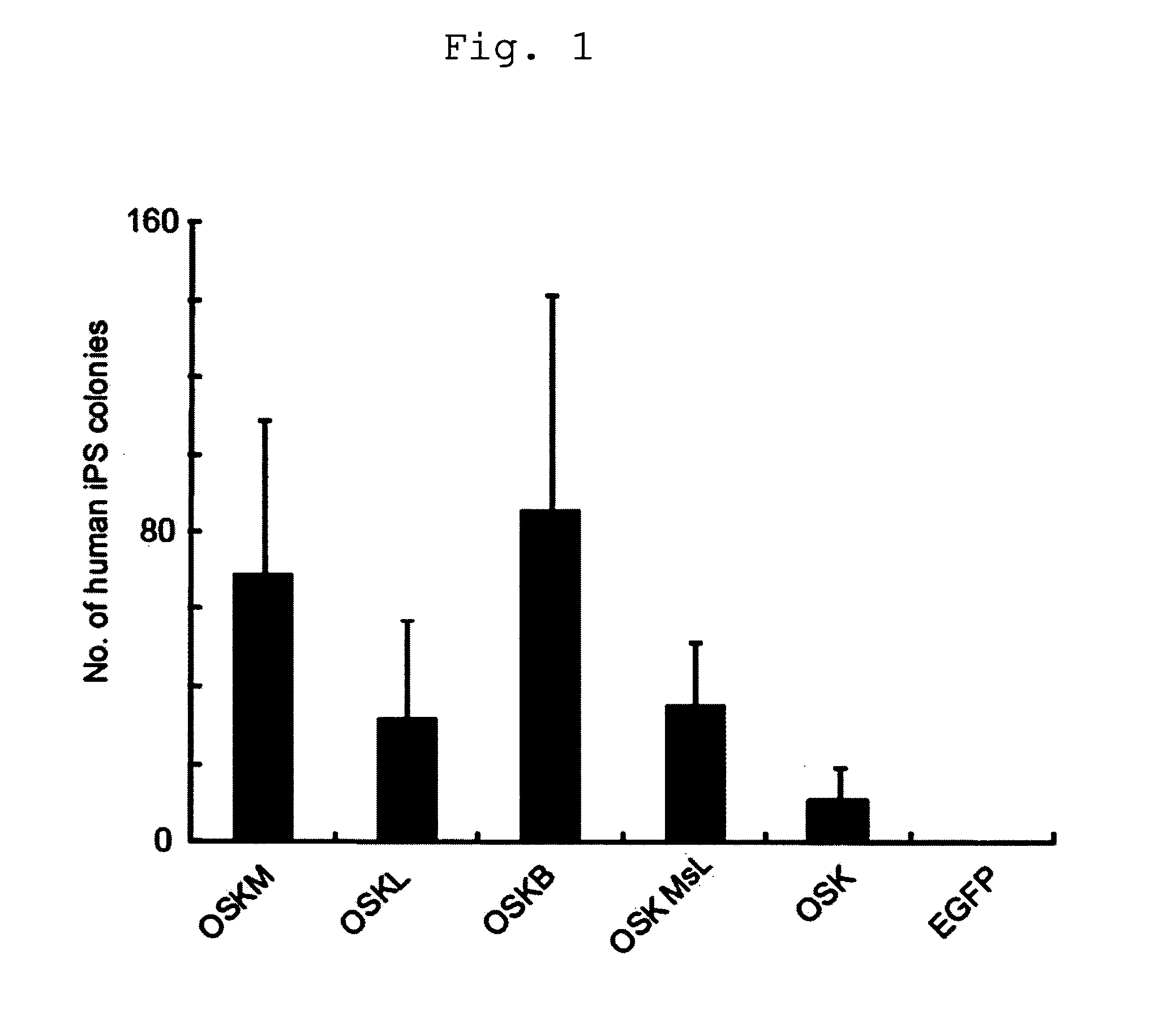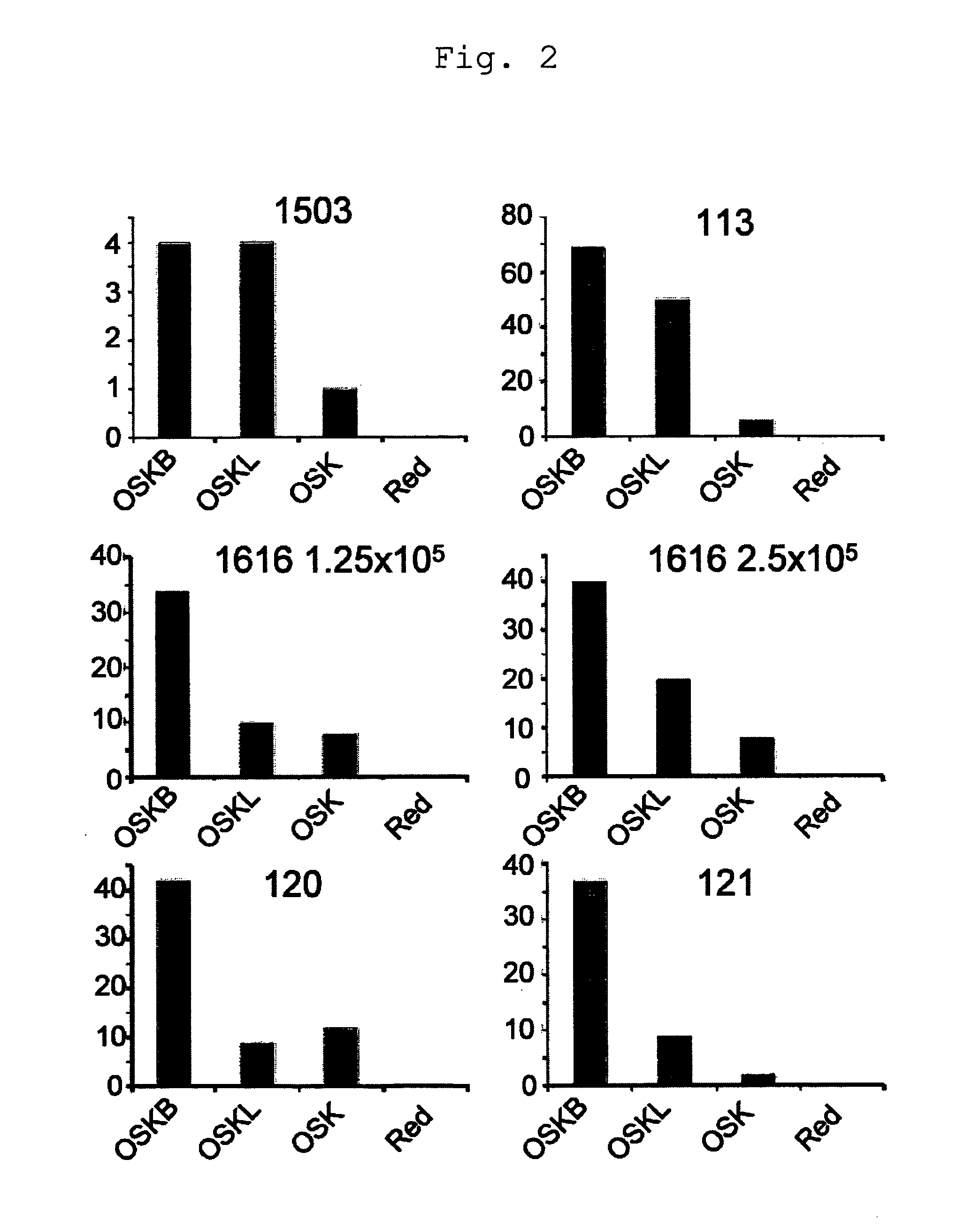Method of efficiently establishing induced pluripotent stem cells
a technology of efficient establishment, which is applied in the field of improving the efficiency of establishing induced pluripotent stem cells, can solve the problems of no disclosure or suggestion regarding the involvement of lin28b, and achieve the effect of improving the establishment efficiency and improving the efficiency of ips cell establishmen
- Summary
- Abstract
- Description
- Claims
- Application Information
AI Technical Summary
Benefits of technology
Problems solved by technology
Method used
Image
Examples
example 1
Comparison of Effects of Lin28 and Lin28B on Establishment of iPS Cells (1)
[0130]Adult human dermal fibroblasts (HDF)(a 36-year-old female Caucasian, cell name 1388) were allowed to express the mouse ecotropic virus receptor Slc7a1 gene using a lentivirus (pLenti6 / UbC-Slc7a1), as described by Takahashi, K. et al. in Cell, 131:861-872 (2007). These cells (1×105 cells / well, E-well plate) were transfected with the following genes using a retrovirus, as described by Takahashi, K. et al. in Cell, 131:861-872 (2007).[0131]1) Human Oct3 / 4, Sox2, Klf4, c-Myc[0132]2) Human Oct3 / 4, Sox2, Klf4, Lin28[0133]3) Human Oct3 / 4, Sox2, Klf4, Lin28B[0134]4) Human Oct3 / 4, Sox2, Klf4, and mouse Lin28[0135]5) Human Oct3 / 4, Sox2, Klf4
[0136]For control, the EGFP gene alone was transferred.
[0137]Seven days after the viral infection, the cells were recovered and re-seeded onto feeder cells (5×105 cells / 100 mm dish). The feeder cells used were SNL cells treated with mitomycin C to terminate the cell division t...
example 2
Comparison of Effects of Lin28 and Lin28B on Establishment of iPS Cells (2)
[0138]The effects of Lin28 and Lin28B on the establishment of iPS cells were compared using the various human dermal fibroblasts (HDFs) shown in Table 1.
[0139]
TABLE 1Cell nameRaceSexAge1503CaucasianFemale73years1616JapaneseFemale68yearsTIG 113JapaneseFemale21yearsTIG 120JapaneseFemale6yearsTIG 121JapaneseMale8months
[0140]These HDFs were allowed to express the mouse ecotropic virus receptor Slc7a1 gene using lentivirus (pLenti6 / UbC-Slc7a1) according to the method described by Takahashi, K. et al. in Cell, 131:861-872 (2007). Transferred to these cells (1×105 cells / well, 6-well plate) were the following genes by means of retrovirus according to the method described by Takahashi, K. et al. in Cell, 131:861-872 (2007).[0141]1) Human Oct3 / 4, Sox2, Klf4, Lin28B[0142]2) Human Oct3 / 4, Sox2, Klf4, Lin28[0143]3) Human Oct3 / 4, Sox2, Klf4
[0144]For control, the DsRed gene alone was transferred.
[0145]Seven days after viral...
PUM
| Property | Measurement | Unit |
|---|---|---|
| temperature | aaaaa | aaaaa |
| diameter | aaaaa | aaaaa |
| time | aaaaa | aaaaa |
Abstract
Description
Claims
Application Information
 Login to View More
Login to View More - R&D
- Intellectual Property
- Life Sciences
- Materials
- Tech Scout
- Unparalleled Data Quality
- Higher Quality Content
- 60% Fewer Hallucinations
Browse by: Latest US Patents, China's latest patents, Technical Efficacy Thesaurus, Application Domain, Technology Topic, Popular Technical Reports.
© 2025 PatSnap. All rights reserved.Legal|Privacy policy|Modern Slavery Act Transparency Statement|Sitemap|About US| Contact US: help@patsnap.com


